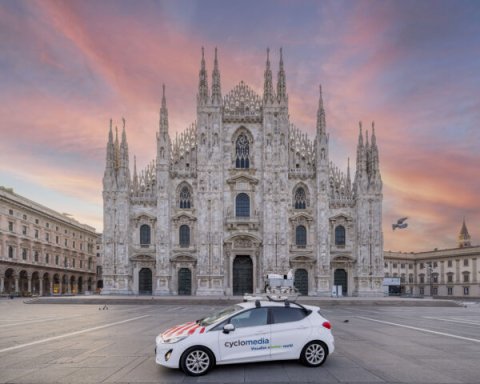Milan Digital Twin: the 3D digital alias of the city - Milan
Milan (Italy)
How difficult is for a city to keep an eye open on the different items that compose the urban landscape? Signals, traffic lights, lamps, billboards, public clocks, dehors, shop windows… sensors of different scopes. They are related to many public services and the need either to consult different database or to check on spot many information is a limit to an efficient and effective reaction to user requests. Milan Digital Twin can dramatically facilitate all that. It is a digital alias of the city. Officials and citizens will be able to conduct immersive navigations of the city and get directly from the digital twin those data that today must be collected from different database or directly on the spot.
The first step of such an ambitious project is completed. An aerial and mobile mapping via 360° cameras of the 2’500 km and 1’550 km2 of public spaces and of the 1.1 million items that compose the urban landscape has been done in the latest months. Collected data have been allowing the update of 22 geodatabases of the City of Milan.
Thanks to Milan Digital Twin it will be possible to render urban projects, to carry out forecasts about the effects on traffic, mobility and public services, demand of new roads, new public transport services, new real estate ventures. It will definitely improve decision making and foresight. It also gives the chance to develop new services for citizens, staff and different stakeholders.
In order to trigger cooperation in developing features and services, some use cases have been preparer.
It allows a full visual interaction with different information about the city, both informative and predictive.
It is expected to simplify access to information for a number of public services. The simple fact that public officers will reduce the need to go on spot for collecting information for service provision implies a sensitive reduction of the administrative burden. Also for citizens, administrative procedures will be lighter. Information exchange can be simplified, permissions and authorizations can be delivered in shorter timing.
At the moment the Digital Twin is not open to citizens, yet, but many use cases have been developed in order to help users to imagine what possible applications such infrastructure will allow.
As an example: For many years the city of Milan has been introducing remedy to the city overheating. Many workshops with citizens have been organized for co-creating possible solutions. Thanks to the Digital Twin it will be possible to install a set of algorithms which will be able to analyze all city roofs and suggest the impact of transforming them in “green roofs”, so as to say roof gardens, or “red roofs”, where to install solar panels. Some algorithms, already developed, can predict, for example, the amount of generated energy considering exposition to the sun and the ROI of the installation. Such a use case has been inspired by Rotterdam Roof Top Catalogue.
• Covered urban surface: 1’500 sqkm (the whole metropolitan area)
• Covered linear public spaces: 2’500 Km (the whole metropolitan area)
• Urban items recorded: 1.1. millions
In a first step, the focus will be on 3 main topics:
- Innovative visualization of urban regeneration projects. The Digital Twin can support participatory processes and make project description easier thanks to immersive visualization.
- City cooling as a critical issue in sustainable urban development. The city has been showing a strong commitment on this topic for many years. Now the digital Twin can offer new opportunities for further development.
- Civil defence against floating, earthquake and other natural disasters. About possible floating, the Digital Twin can help conducting sharper predictive analysis about possible impacts of a floating event. That could bring, as a consequence, to an impact for assurance prices for shops at the ground level, as most of them are nowadays considered at high risk and a sharper analysis could re-label them at a lower degree in the scale.
